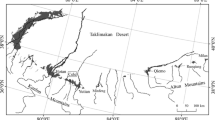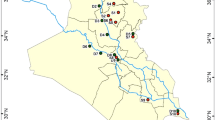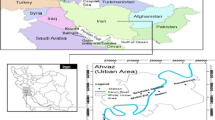Abstract
The dust storms that blow over Iraq were studied from December 2008 to March 2009. The total number of studied dust storms was eight; during each dust storm, samples were collected from the cities of Baghdad, Ramadi, Kut, Basra, Najaf, Karbala, Hilla and Tikrit. The climatic elements with the dust storms types were studied. The results of dust storms analyses reflect their increase in average toward the southwestern direction (average suspended, rising, regional dust storms were 8, 10, 15 days/year, respectively). The average means annual rainfall (in mm), evaporation (in mm), temperature (in °C), and relative humidity percentage indicate that there were remarkable variations in values, with increase of the number of days/years of the dust storms reflecting the effect of the regional climatic change. The results of particle size analyses indicate the texture of most samples range from sandy clayey silt (75%) and clayey sandy silt (25%), and the average dominant grain size have a direct relationship with trajectories of dust storms. Quartz grains were 15% rounded and 85% sub-rounded. Moreover, the dust samples were analyzed and identified by using XRD analyses and Polaroid microscope. The results reflect the following minerals according to their average relative dominant, quartz 58.6%, feldspars 17.3%, and calcite 15.4%, with small amount of gypsum 5.5%. The clay minerals (chlorite, illite, montmorillonite, palygorskite, and kaolinite) were recognized. The analyses of heavy minerals percentages by using the microscope were performed. The results of pollen distribution, in descending order, were Chenopodiaceous, Graminea, Pine, Artemisia, Palmae, Olea, and Typha (reaching 79%, 69%, 63%, 53%, 17%, 9%, and 7% of the counted pollen grains, respectively). The results of microorganisms (i.e., isolated bacteria and fungi), in descending order, were the gram-positive Bacillus species (42.9%), Aspergillus species plus Candida albicans (13.8%), and (8.4%), the gram-negative rods, Escherichia coli (9.5%), the gram-positive Cocci streptococcus pneumonia (6.7%), then the gram-negative rod Enterobacter cloacae (4.3%), Staphylococcus epidermidis, and Staphylococcus (3.9%) and (1.9%). The remaining Gram-negative microorganisms were Pseudomonas aeruginosa (2.7%). Regarding the viral etiology, there is no viral isolate among the work results. The allergens commonly associated with dust storms include fungal spores, plant and grass pollens, and organic detritus represent agricultural area pollen grains.
المستخلص
تمت دراسة العواصف الغبارية الهابة على العراق للفترة من كانون ثاني (ديسمبر) 2008 ولغاية أذار (مارس) 2009 . لقد كان عدد العواصف الغبارية المدروسة هو ثمانية ، تم جمع نماذج الغبار لكل عاصفة من مدن بغداد والرمادي والكوت والبصره و النجف وكربلاء والحله وتكريت . وشملت الدراسة تحليل العناصر المناخية وانواع العواصف الغبارية .أظهرت النتائج بان معدلات العواصف الغبارية تزداد باتجاة الجنوب الغربي ( حيث كانت معدلات عواصف الغبار العالق و المتصاعد والعواصف الاقليمية هو 8 و 10 و 15 يوم / سنة ، على التوالي ). كما بينت المعدلات السنوية للامطار ( ملم) و التبخر (ملم) والحرارة ( درجة مئويه) والرطوبه النسبيه ( %) بانها متغايره مع الزمن وتدل مع زيادة عدد الايام في السنه للعواصف الغبارية بتاثير التغير المناخي العالمي. دلت نتائج التحاليل النسيجيه لحجوم الدقائق الغبارية بانها غرين طيني رملي بنسبة 75% و غرين رملي طيني بنسبة 25% وان الحجوم المتغلبة ذات علاقة طردية مباشره بطاقة العواصف الغبارية. أظهرت دراسة استدارة شكل حبيبات معدن الكوارتز , أن أشكالها كانت تتراوح بين شبه الدائري (85%) ودائري ( 15%) .
اوضحت تحاليل النماذج الغبارية بواسطة أشعة أكس والمجهر المستقطب بان معدلاتها المعدنية تتكون من معادن الكوارتز 58,6 % والفلدسبار 17,3 % والكالسايت 15,4% مع نسبه قليلة من الجبسوم 5,5 % , مع وجود المعادن الطينية الكلورايت والألايت والمنتمورلولايت والباليغوسكايت والكاؤولينايت . كما اوضحت الدراسة الحالية انواع المعادن الثقيلة في نماذج الغبار
شملت الدراسة أيضا حبوب اللقاح المنقوله بواسطة العواصف و تراكيزها ، وأمكن تمييز حبوب اللقاح العائدة للعوائل النباتية وهى ( رجل الوزة 79% والنجيلية 69% والصنوبرية 63% والزيتونية 9% والنخيل 17% والبردى 7% ) منقولة بالعواصف الترابية التي مرت بالعراق خلال فترة الدراسة, اما من ناحية الدراسات البايولوجية فقد تم دراسة انواع البكتريا والفطريات والفيروسات المرضية وغير المرضية . أظهرت الدراسة الحالية للغبار أن معظم البكتريا المعزولة هي عصيات الباسيلاس الموجبة 42,9% وتأتي بعدها العصيات المعوية السالبة 9,5% والمكورات الموجبة الرئوية والمكورات الموجبة الجلدية 6,7% وعصيات سالبة معوية مختلفة منها الكلوكا 4,3% والكوكاس النوع الاول 3,9% والثاني 1,9% والبسيدوموناس 2,7% , أما بالنسبة للفطريات المرضية المعزولة فكان بالمرتبة الأولى الأسبيرجيليس الرئوية 13,8% وثانيا الكانديدا المرضية8,4% , ومن خلال الدراسة الحالية لم يتم عزل أي فيروس مرضي أو غير مرضي.
ان التاثيرات الطبية السلبية للعواصف الغبارية كانت كثيرة اهمها امراض الربو والحساسية وامراض الجهاز التنفسي وكانت بسبب العوالق من السبورات وحبوب اللقاح النباتية والمواد العضوية العالقة الاخرى واشكالها المخرشة للجهاز التنفسي التي تمثل المناطق الزراعية التي تمر عليها العواصف اضافة الى المكونات المعدنية المختلفة.







Similar content being viewed by others
References
Abdul Hameed A (2003) Airborne particulate matter and its viable fraction during severe weather conditions in Cairo. Air pollution Department National Research Center, Egypt
Al-Ali JT (2003) Dust storms contribution of Khor Al-Zubair and Khor Abdallah Deposits, Journal of the Iraqi geographical society, No. 53.(In Arabic)
Al-Ali JT, Abdul Jabbar CH, Hassan H (2005) Effect of marshlands drying process on regional dust fallout, Wade Al- Rafedian Magazine No. 16, pp. 261–272 (In Arabic)
Al-Dabbas M, Al-Saadi Q, Bakhtash F (2008) Combating desertification in Iraq, Unpub. Report for ASTF Scientific Workshop, UAE
Al-Frayh AR, Shakoor Z, God el Rab MO, Hasnain SM (2001) Increased prevalence of asthma in Saudi Arabia. Ann Allergy Asthma Immunol 86:292–296
Al-Jannabi KZ, Jawad A (1988) Origin and nature of s and dunes in the alluvial plain of southern Iraq. J Arid Environ 14:27–34
Al-Khafaji RMN (2009) Effects of dust storms on some Iraqi territories, Ph.D., thesis, College of Science, University of Baghdad.
Al-Saad HT, Abed SN (2006) The contamination Air, Univ. of Basrah, center Science Sea, First edit, p. 84–85 (In Arabic).
Al-Sultani ARA (2006) Pollution air and soil Nahrawan regions East of Baghdad in heavy metals producing from stones factors, Unpub. M.Sc. Thesis, Geology Dept., Sci. College, Univ. of Baghdad. (In Arabic).
Al-Ubaidi KH (2006) Identification and measurements of natural and industrial radioactive pollutants in environment of Baghdad City using gamma spectrometry and solid state nuclear track detector CS-39, unpub. Ph. D. theses, Education Coll./Ibn Al- Haitham, Baghdad Univ., P.58 (In Arabic).
Darmoian SA (2000) Sedimentary characters and accumulation of dust fallout southern Mesopotamian plain, Basrah. J Science 18(1):141–156
Delfino RJ, Sioutas C, Malik S (2005) Potential role of ultra fine particles in associations between airborne particle mass and cardiovascular health. Environ Health Perspect 113:934–946
Dougramedji J, Asador Hamparsoum K (1996) Geomorphological and mineralogical study for some sand dunes near to Saddam River which covered for surface soils strata. J The scientific and Agricultural Iraqi 27(2):9–17, In Arabic
Folk RL (1974) Petrology of sedimentary rocks. Hemphill, Austin, p 182
Garrison VH, Foreman WT, Genwaldi S et al (2006) Saharan dust—a carrier of persistent organic pollutants, metals and microbes to the Caribbean. Rev Biol Trop J 54(suppl3):9–21
Griffin DW (2007) Atmospheric movement of microorganisms in clouds of desert dust and implications for human health. Clin Microbiolrev 13:450–477
Griffin DW, Kubilary N, Kocak M (2007) Airborne desert dust and aeromicrobiology over the Turkish Mediterranean coastline. Atmos Environ 41:4050–4062
Hammond GW, Raddatz RL, Gleskey DE (1989) Impact of atmospheric dispersion and transport of viral aerosols on the epidemiology of influenza. Rev Infect Dis 11:494–497
Hem JD (1989) Study and Interpretation of the chemical characteristics of natural water, U.S.G.S. water supply, Washington, paper 2254, p 264.
Iraqi Meteorological Department, Directorate of Climatology, and Directorate of Hydro- and Agricultural Meteorology, (2008) General climatological data of all meteorological stations, Ministry of Transportation/Iraqi Meteorological Organization.
Jackson NO, Schmiieger H, Kayiko M (1997) Bacillus cereus may produce two or more diarrhea enter toxin. FEMS Microbiol Lett 149:245–248
Jassim SY (2007) Palynological and archaeological evidence for early Mesopotamia during quaternary, Unpub. Ph.D.,thesis, University of Baghdad.
Kuske CR, Barns SM, Grow CC, Merrill L, Dunbar MS, Dunbar J (2006) Environmental survey for four pathogenic bacteria and closely related species using phylogenetic and functional genes. J Forensic Sci 51:458–558
Kutiel H, Furman H (2003) Dust Storms in the Middle East: source of origin and their temporal characteristics. Indoor Built Environ 12:419–426
Martiny JB, Bohannon BJ, Brown JH, Colwell RK, Fuhrman JA, Green JL, Horner-Devine MC, Kane M, Krumins JA, Kuske CR, Morin PJ, Naeem S, Ovreas L, Reysenbach AL, Smith VH, Staley JT (2006) Microbial biogeography: putting microorganisms on the map. Nat Rev Microbiol 4:102–112
Middleton NJ (2001) Dust storms in the Middle East. J Arid Environ 10:83–96
Moore PD, Webb JA (1978) An illustrated guide to pollen analysis, Hodder and Stoughton, London, 133 pages and 48 plates.
Poschl U (2005) Atmospheric aerosols: composition, transformation, climate and health effects, Angew. Chem. Int. Edit., 44: 7520-7540
Power MC (1953) A new roundness scale for sedimentary particles. J Sediment Petrol 23:117–119
Prospero JM (1999) Long-range transport of mineral dust in the global Atmosphere, impact of African dust on the environment of the south east United states, the National Academy of Sciences Colloquium, Geology Mineralogy and Human Welfare, vol. 96, issue 7: 3396–3403
Schmaltz J (2008) Visible earth dust storm in Iraq, June 08, p1.,NASA Image.
Shoor AF, Scoville SL, Cersovsky SB, Shanks D, Ockenhouse CF, Smoak BL, Carr WW, Petruccelli BP (2004) Acute eosinophilic pneumonia among US military personnel deployed in or near Iraq. JAMA 292:2997–3005
Taylor PE, Jonsson H (2004) Thunderstorm asthma. CurrAllergy Asthma Rep 4:409–413
WHO, World Health Organization, (1996) Air quality guide lines for Europe, Copenhagen, World Health Organization, Regional office for Europe
WHO, World Health Organization, (2004) Manual for the virological investigation of polio (4th ed.).
Willard DA, Cooper SR, Gomez D, Jensen J (2004) Atlas of pollen and spores of the Florida Everglades. Palynology 28:175–227
Acknowledgments
The researchers wish to thank Dr. Abdalla Al-Najjar (the chairman of ASTF) and the Arab Science and Technology Foundation (ASTF) for their great support. We wish to extend our gratitude to Dr. Ahmed Alose (ASTF Main Office, UAE) for his encouragement to publish this research and to Dr. Ausama Sameh (ASTF, Baghdad) for his continuous support. Special thanks are due to Dr. Virginia H. Garrison (U.S. Geological Survey) for her encouragement during reading the original manuscript.
Author information
Authors and Affiliations
Corresponding author
Rights and permissions
About this article
Cite this article
Al-Dabbas, M.A., Ayad Abbas, M. & Al-Khafaji, R.M. Dust storms loads analyses—Iraq. Arab J Geosci 5, 121–131 (2012). https://doi.org/10.1007/s12517-010-0181-7
Received:
Accepted:
Published:
Issue Date:
DOI: https://doi.org/10.1007/s12517-010-0181-7




